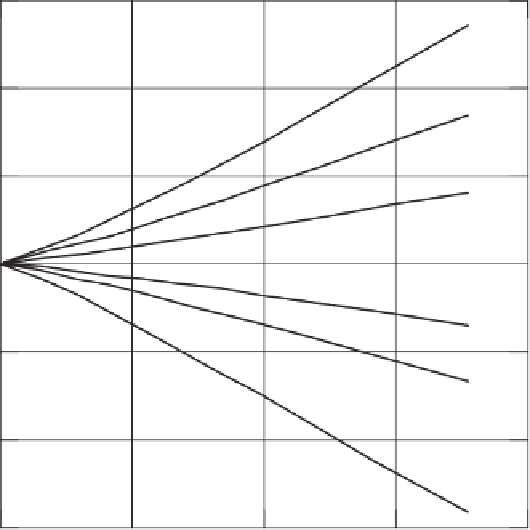Environmental Engineering Reference
In-Depth Information
Campbell et al. (1994) reported that a correction needed to
be applied to the thermal conductivity of dry air in order to
accommodate the latent heat transport term when moisture
vapor was present in the air. A procedure was proposed for
the calculation of the soil suction corrected for temperature
and the thermal conductivity of water vapor in the air phase.
Figure 4.58 shows the possible variation in thermal conduc-
tivity reading when the ambient temperature is different than
20
◦
C. The results show, for example, that if the soil suction
were 400 kPa and the temperature varied by plus or minus
10
◦
C, the error in the soil suction measurement could be plus
or minus 100 kPa (i.e., values between 300 and 500 kPa).
The research results reported by Flint et al., (2002) raise a
number of questions related to the calibration and usage of
heat dissipation sensors. The research suggests that the most
significant temperature effects occur as the temperatures and
soil suctions increase. The results assume that no temper-
ature correction is required when the thermal conductivity
suctions sensors are essentially filled with water. When the
measured soil suctions are about 250 kPa, it is estimated
that the measured suction could be as high as 310 kPa if the
ambient temperature were 30
◦
C, and as low as 180 kPa if
the ambient temperature were 10
◦
C.
thermal conductivity suction sensors. Figure 4.59 shows
the influence of changing the ambient temperature from
about 23
◦
C to the freezing point. The Shuai et al., (2002)
temperature corrections were applied to the measurements.
The results showed that soil suction remained essentially
constant except when the temperature was reduced to
freezing conditions. The soil suction readings dropped to
zero when the soil became frozen. Later the soil suctions
returned to their original values when the soil thawed.
There was no apparent damage to the sensors upon freezing.
It was reasoned that the soil suction readings dropped to zero
because the imposed heat pulse was absorbed by latent heat.
4.2.9.8 Effect of Hysteresis in the TC Suction Sensors
One of the limitations associated with any indirect measure-
ment system is the issue of hysteresis. The water content
versus matric suction curves for any porous material are not
the same during wetting and drying. The hysteresis associ-
ated with the water retention curves for the ceramic results
in hysteresis in the suction sensor response upon wetting
and drying. Attempts have been made to take the capillary
hysteresis of the porous ceramic tip into consideration when
measuring matric suction (Feng, 1999).
Desorption and adsorption curves have been measured
for the ceramic used for the GCTS thermal conductivity
suction sensors. A typical set of drying and wetting water
retention curves for the porous ceramic used for the sens-
ing tip is shown in Fig. 4.60. The results show that there is
4.2.9.7 Effect of Freezing Temperature on Thermal
Conductivity Suction Measurements
Shuai et al., (2002) conducted other tests to assess the
effect of temperature on suction measurements when using
600
30
°
C
400
24
°
C
200
22
°
C
0
18
°
C
-200
16
°
C
-400
10
°
C
-600
0
500
1000
1500
2000
Matric suction (kPa)
Figure 4.58
Possible measurement error for range of ambient temperatures and soil suctions
up to 1750 kPa (after Campbell Scientific Instruction Manual, 2009).











Search WWH ::

Custom Search